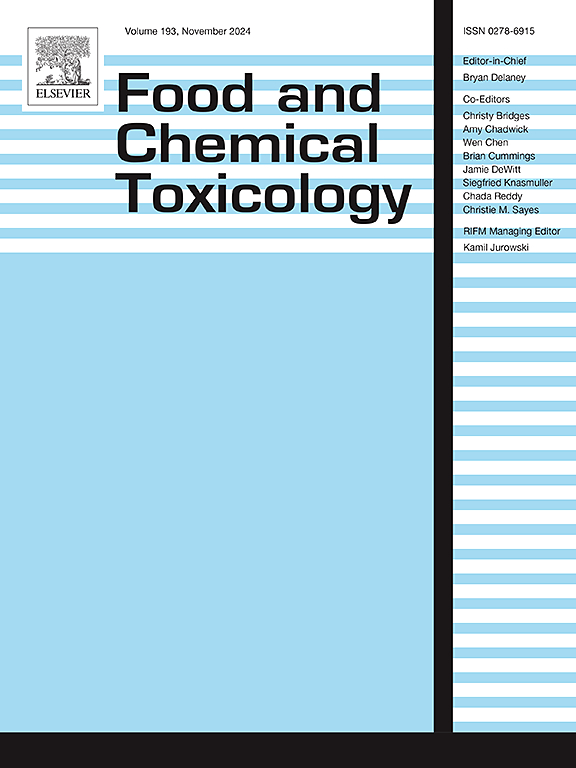Attenuation of Paclitaxel-induced toxicities by polyphenolic natural compound rutin through inhibition of apoptosis and activation of NRF2/ARE signaling pathways
IF 3.9
3区 医学
Q2 FOOD SCIENCE & TECHNOLOGY
引用次数: 0
Abstract
Paclitaxel is the first microtubule-stabilizing drug widely used as an antineoplastic agent. Hepatotoxicity, nephrotoxicity and myeloid suppression may lead to secondary malignancy which is an important adverse effect of paclitaxel-therapy. In this study, we have evaluated the potential protective role of natural flavonoid rutin against paclitaxel-induced toxicities in BALB/cmice. Paclitaxel was administered intraperitoneally (in alternate days at a dose of 8.5 mg/kg b.w.) and rutin was given every day by oral gavages (20 mg/kg b.w.) in BALB/c mice. Results showed that administration of paclitaxel significantly (P<0.05) increased the generation of ROS and NO in bone marrow, liver and kidney tissues. In contrast, co-administration of rutin and paclitaxel significantly (p<0.05) reduced the intracellular ROS and NO levels, reversed the toxic effects of paclitaxel through NRF2-mediated activation of antioxidant response element (ARE) pathway and upregulated activity of several phase-II antioxidant enzymes. Furthermore, rutin treatment inhibited apoptosis by downregulated expression of Bax, caspase-3 and cPARP in bone marrow, liver and kidney tissues. Additionally, the chemoprotective potential of rutin was confirmed by histopathological analysis. Thus, our results suggest that co-administration of rutin may serve as a promising preventive strategy against paclitaxel induced toxicities and indicate its future use as an adjuvant in chemotherapy.

多酚类天然化合物芦丁通过抑制细胞凋亡和激活NRF2/ARE信号通路来减弱紫杉醇诱导的毒性。
紫杉醇是第一个微管稳定药物,广泛用作抗肿瘤药物。肝毒性、肾毒性和骨髓抑制可导致继发性恶性肿瘤,这是紫杉醇治疗的一个重要不良反应。在这项研究中,我们评估了天然类黄酮芦丁对紫杉醇诱导的BALB/ c小鼠毒性的潜在保护作用。BALB/c小鼠腹腔注射紫杉醇(隔天给药,剂量为8.5 mg/kg b.w.),每天灌胃芦丁(20 mg/kg b.w.)。结果表明,紫杉醇组明显改善了小鼠的生理功能(P
本文章由计算机程序翻译,如有差异,请以英文原文为准。
求助全文
约1分钟内获得全文
求助全文
来源期刊

Food and Chemical Toxicology
工程技术-毒理学
CiteScore
10.90
自引率
4.70%
发文量
651
审稿时长
31 days
期刊介绍:
Food and Chemical Toxicology (FCT), an internationally renowned journal, that publishes original research articles and reviews on toxic effects, in animals and humans, of natural or synthetic chemicals occurring in the human environment with particular emphasis on food, drugs, and chemicals, including agricultural and industrial safety, and consumer product safety. Areas such as safety evaluation of novel foods and ingredients, biotechnologically-derived products, and nanomaterials are included in the scope of the journal. FCT also encourages submission of papers on inter-relationships between nutrition and toxicology and on in vitro techniques, particularly those fostering the 3 Rs.
The principal aim of the journal is to publish high impact, scholarly work and to serve as a multidisciplinary forum for research in toxicology. Papers submitted will be judged on the basis of scientific originality and contribution to the field, quality and subject matter. Studies should address at least one of the following:
-Adverse physiological/biochemical, or pathological changes induced by specific defined substances
-New techniques for assessing potential toxicity, including molecular biology
-Mechanisms underlying toxic phenomena
-Toxicological examinations of specific chemicals or consumer products, both those showing adverse effects and those demonstrating safety, that meet current standards of scientific acceptability.
Authors must clearly and briefly identify what novel toxic effect (s) or toxic mechanism (s) of the chemical are being reported and what their significance is in the abstract. Furthermore, sufficient doses should be included in order to provide information on NOAEL/LOAEL values.
 求助内容:
求助内容: 应助结果提醒方式:
应助结果提醒方式:


